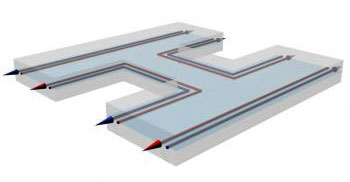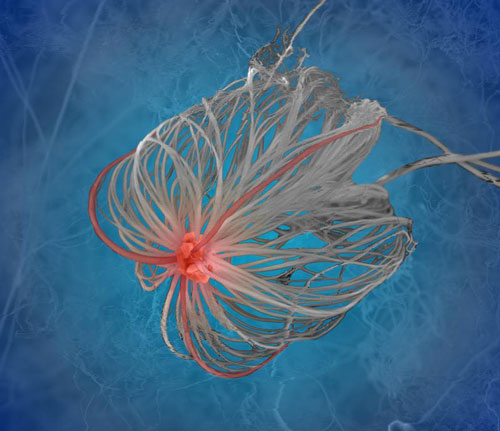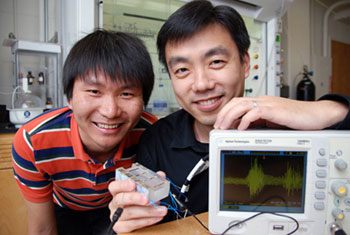Nanofair 2012 - Call for Papers gestartet
Ab sofort koennen Beitraege fuer die Nanofair 2012 in Dresden eingereicht werden.
Oct 4th, 2011
Read more
Ab sofort koennen Beitraege fuer die Nanofair 2012 in Dresden eingereicht werden.
Oct 4th, 2011
Read more Scientists at Stanford and SLAC have found a potential way to harness the amazing properties of topological insulators - materials that conduct electricity only along their surfaces - for use in electronics and other applications.
Scientists at Stanford and SLAC have found a potential way to harness the amazing properties of topological insulators - materials that conduct electricity only along their surfaces - for use in electronics and other applications.
Oct 4th, 2011
Read more By using lasers to help grow nanotubes on a silicon plate, the researchers have created structures that, when viewed under a scanning electron microscope, resemble a jellyfish in the ocean. This image was recently awarded first prize in the national photo competition "Making Nano Visible."
By using lasers to help grow nanotubes on a silicon plate, the researchers have created structures that, when viewed under a scanning electron microscope, resemble a jellyfish in the ocean. This image was recently awarded first prize in the national photo competition "Making Nano Visible."
Oct 4th, 2011
Read moreUse of oxygen isotope substitution will lead to more accurate structural modelling of oxide materials found in everything from biological processes to electronic devices.
Oct 4th, 2011
Read moreScientists have created a working cloaking device that not only takes advantage of one of nature's most bizarre phenomenon, but also boasts unique features; it has an 'on and off' switch and is best used underwater.
Oct 4th, 2011
Read more The same piezoelectric effect that ignites your gas grill with the push of a button could one day power sensors in your body via the respiration in your nose.
The same piezoelectric effect that ignites your gas grill with the push of a button could one day power sensors in your body via the respiration in your nose.
Oct 4th, 2011
Read moreThe 2012 Guinness World Records has been published and confirms that scientists at The University of Nottingham hold the record for writing the world's smallest periodic table.
Oct 3rd, 2011
Read moreSanford-Burnham and Salk Institute scientists combine tumor-targeting peptides and nanoparticles to eliminate glioblastoma in a previously untreatable mouse model.
Oct 3rd, 2011
Read moreAt a visit this morning to the University laboratories where the material's remarkable properties were first demonstrated, the Chancellor laid out his plans for the creation of a Graphene Global Research and Technology Hub to commercialise graphene, part of almost GBP 200m investment into science.
Oct 3rd, 2011
Read moreA University of Arkansas researcher has patented a process that reduces the time it takes to perform DNA analysis from hours to minutes. This development could contribute to many areas of health care and law enforcement, including diagnosing and treating disease, developing and testing new vaccines and forensic identification.
Oct 3rd, 2011
Read moreThe White House announced that Lan Yang, PhD, assistant professor of electrical and systems engineering in the School of Engineering and Applied Science of Washington University in St. Louis has been named a recipient of the Presidential Early Career Awards for Scientists and Engineers (PECASE).
Oct 3rd, 2011
Read moreTransparent high-performance electronic devices made with new nano-structured materials that substitute silicon open the door to a new, greener era for technology.
Oct 3rd, 2011
Read moreThe British Occupational Hygiene Society is hosting an International Conference on Working Safely with Nanomaterials in Edinburgh, Scotland on 6 July 2012.
Oct 3rd, 2011
Read moreA new review published in WIREs Nanomedicine and Nanobiotechnology explores how nanotechnology may be used to develop safer breast implants as an alternative to silicone rubber, minimizing health complications.
Oct 3rd, 2011
Read moreThe focus of the project cluster is on continuing the development of Nanoimprint Lithography (NIL) in the scope of eight tangible research projects. PROFACTOR, as the coordinator, will guide the combined forces of all research institutes in the country involved in NIL research and a number of enterprises interested in Nanoimprint Lithography applications.
Oct 3rd, 2011
Read moreMansoor Amiji, Distinguished Professor and Chair of the Department of Pharmaceutical Sciences at Northeastern University, has designed a nano-cocktail that targets multi-drug resistant tumors with remarkable accuracy and makes chemotherapy more efficient.
Oct 3rd, 2011
Read more